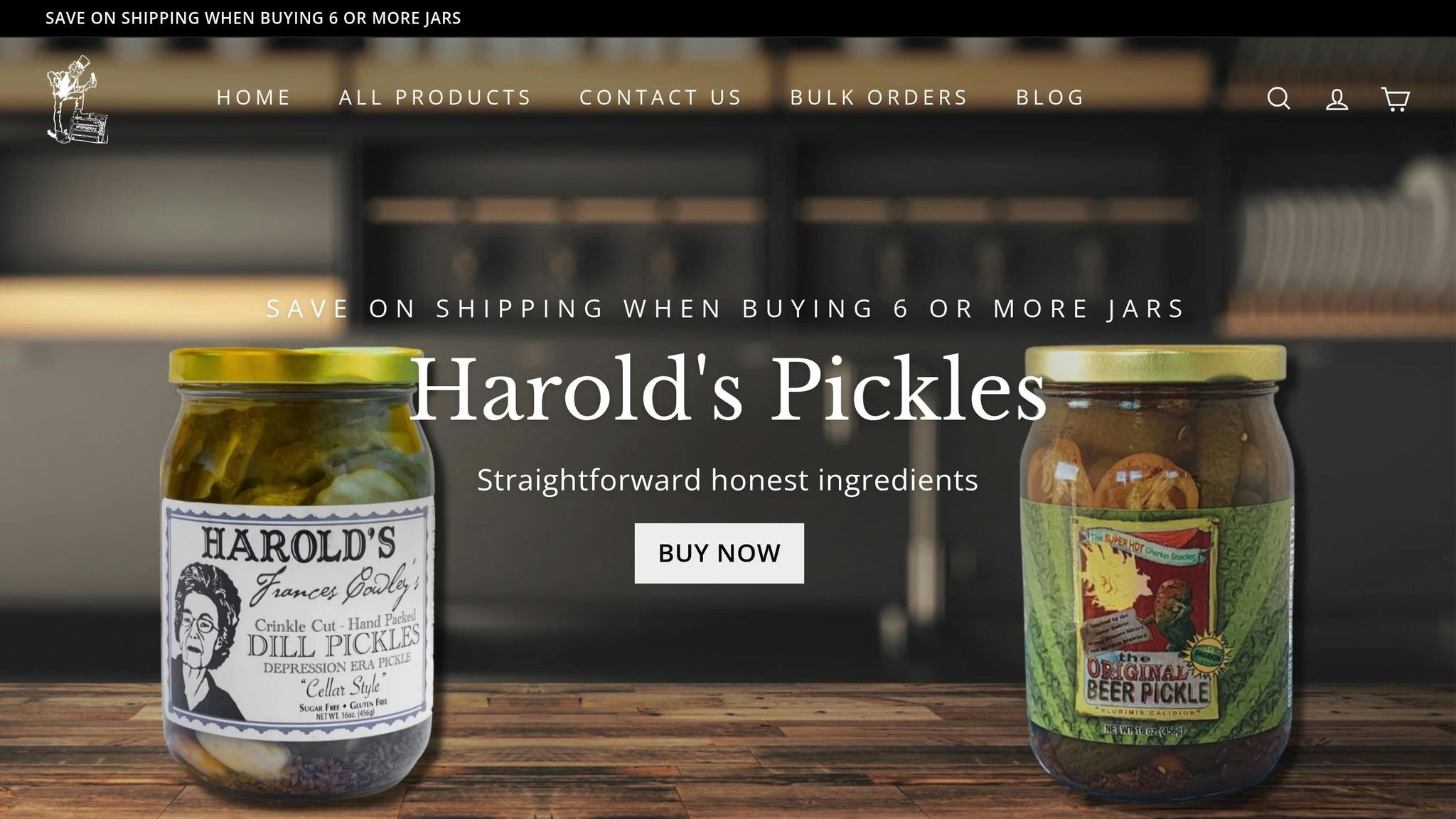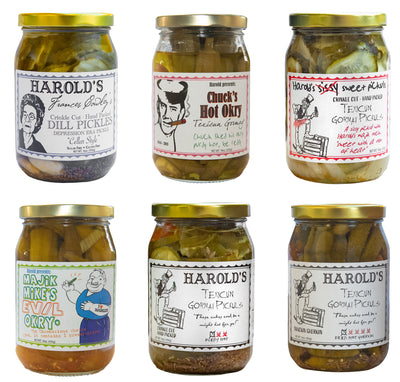Dill vs Sweet Pickles: Which Tastes Better?
Dill pickles bring a tangy, bold flavor loved for their sour kick, while sweet pickles offer a mild, sugary taste with a hint of tang. Dill pickles dominate the U.S. market, accounting for 50–65%, while sweet pickles hold 20–30%, with regional preferences playing a role - sweet pickles are popular in the South, and dill pickles are a staple in New York delis.
Here’s a quick breakdown:
- Dill Pickles: Crisp, tangy, great for savory dishes like sandwiches and burgers. Low in calories but high in sodium.
- Sweet Pickles: Mildly sweet, perfect for salads, barbecue sides, or tartar sauce. Higher in sugar and calories but lower in sodium.
Both types can offer probiotic benefits if fermented, making them a gut-friendly choice. Ultimately, the best pickle depends on whether you prefer a bold tang or a touch of sweetness.
Dill Pickles vs. Bread & Butter Pickles #vs #dillpickles #pickles #breakandbutter #livelife365
Flavor Profiles and Ingredients
Dill and sweet pickles each bring their own distinct personalities to the table, crafted with unique ingredients that define their flavors and culinary uses. Let’s take a closer look at what sets them apart.
What Gives Dill Pickles Their Tangy, Bold Flavor?
Dill pickles are all about that tangy punch, thanks to their brine. White vinegar lays the foundation with its sharp acidity, transforming cucumbers into pickles. Fresh or dried dill adds an unmistakable herbal freshness, while garlic cloves lend a savory depth. Salt not only enhances the flavor but also draws out moisture from the cucumbers, helping to preserve their crunch. To round it all out, a mix of spices brings subtle heat and earthy undertones, complementing the bold, tangy profile without overpowering it.
Sweet Pickles: A Perfect Blend of Sugar and Spice
Sweet pickles take a different approach, balancing tanginess with a distinct sweetness. A generous amount of sugar or corn syrup is added to the brine, softening the vinegar’s sharpness and letting the sweetness shine. Spice blends like mustard seed, celery seed, and turmeric (which gives them a golden hue) create a harmonious flavor. Some recipes go a step further, incorporating warming spices like allspice, cloves, or ginger for added depth. Onions often make an appearance to balance the sweet-and-tangy combination, while garlic is used sparingly. Across the U.S., regional recipes tweak these ingredients to create even more variations.
Regional Pickle Variations Across the U.S.
American pickles showcase an impressive diversity of flavors, shaped by regional traditions. In the South, sweeter pickles often have a higher sugar content and may include extras like bell peppers and onions - think bread and butter pickles. New York-style kosher dill pickles are famous for their garlicky, salty brine and heavy use of dill. In the Midwest, half-sour pickles are popular for their crisp texture and mild sourness. Meanwhile, on the West Coast, pickle makers are known for experimenting with hybrid recipes, often adding unexpected ingredients. Local climates and traditions have influenced pickling techniques, resulting in a wide variety of textures and flavors that reflect the country’s culinary diversity.
How to Use Each Pickle Type
Pickles can transform a dish, adding just the right mix of flavor and texture. Whether you prefer dill or sweet pickles, understanding their unique qualities can help you make the most of them in your cooking.
Dill Pickles: Perfect for Savory Dishes
Dill pickles are a go-to for savory recipes. They bring a crisp, tangy bite that pairs beautifully with sandwiches, burgers, hot dogs, and charcuterie boards. Their sharpness cuts through rich ingredients like mayo, cheese, or cured meats, offering a refreshing contrast. They also work as excellent palate cleansers and are a satisfying low-calorie snack straight out of the jar. While dill pickles dominate in savory settings, sweet pickles have their own special place in the kitchen.
Sweet Pickles: A Touch of Sweetness
Sweet pickles, with their mild sugary flavor, add a delightful twist to dishes. They’re a fantastic addition to potato salad, coleslaw, and barbecue sides. Finely chopped, they bring both texture and flavor to creamy salads, tartar sauce, pulled pork, or even fried foods. Their subtle sweetness balances out tangy or smoky flavors, making them a versatile choice for many recipes.
Harold's Pickles Product Line

Harold's Pickles offers a selection tailored to these culinary uses, ensuring you’ll find the perfect pickle for your needs.
- Francis Cowley's Dill Pickles: These deliver the classic dill flavor with premium ingredients, making them ideal for sandwiches, burgers, or appetizer spreads.
- Harold's Texicun Gormay Pickuls: For those who crave a kick, this spicy option blends heat with bold flavor, perfect for Mexican-inspired dishes, spicy sandwiches, grilled meats, or even a fiery Bloody Mary.
Harold's Pickles products are crafted with care, offering distinct flavors that elevate any meal. Whether you’re sticking to tradition or experimenting with spice, there’s a pickle for every occasion.
Nutrition Facts: Dill vs Sweet Pickles
When deciding between dill and sweet pickles, knowing their nutritional differences can help you choose the right fit for your diet. These two types vary in calories, sugar, and sodium, which can influence how they align with your health goals and culinary preferences.
Dill Pickles: A Low-Calorie Choice
If you're watching your calorie intake, dill pickles are the go-to option. A single dill pickle spear contains just 4–5 calories, making it a great snack for those focused on weight management. Plus, with less than 1 gram of sugar per serving, dill pickles are well-suited for low-carb diets.
However, there’s a trade-off: dill pickles are typically higher in sodium, with about 200–400 mg per spear. This saltiness comes from the brine used during pickling, which not only preserves the pickles but also gives them their signature tangy kick.
In short, dill pickles deliver crunch and flavor without piling on the calories.
Sweet Pickles: A Sweeter Alternative
Sweet pickles, on the other hand, pack more calories and sugar. Each piece contains about 15–20 calories and 3–4 grams of sugar, thanks to the sweeteners used during the pickling process. If you're following a low-sugar diet, sweet pickles might not be the best choice.
On the upside, sweet pickles generally have slightly less sodium than dill pickles, ranging between 150–300 mg per serving. However, sodium levels can vary depending on the recipe.
Probiotic Perks of Fermented Pickles
Both dill and sweet pickles can offer probiotic benefits, but only if they’re fermented. Fermented pickles are made with a salt brine that fosters the growth of beneficial bacteria, unlike quick-pickled varieties that use vinegar and lack live cultures.
Fermented pickles - whether dill or sweet - are rich in probiotics, which can promote gut health, support digestion, boost immunity, and even help reduce inflammation. Fermentation has been a preservation method for thousands of years, with evidence of its use dating back over 4,000 years.
To enjoy the probiotic benefits, look for labels that mention fermentation or live cultures.
Here’s a quick breakdown of their nutritional differences:
| Nutritional Comparison | Dill Pickles (per spear) | Sweet Pickles (per piece) |
|---|---|---|
| Calories | 4–5 | 15–20 |
| Sugar | <1 g | 3–4 g |
| Sodium | 200–400 mg | 150–300 mg |
| Probiotic Potential | Yes (if fermented) | Yes (if fermented) |
Both dill and sweet pickles can be part of a balanced diet as long as they’re enjoyed in moderation.
sbb-itb-820fb79
Taste Preferences and Regional Trends
Savory vs Sweet: Personal Taste Factors
When it comes to pickles, personal taste plays a huge role in shaping your preferences. Some people are drawn to the tangy, bold kick of dill pickles, while others lean toward the milder, sugary flavor of sweet pickles. It all boils down to what your palate craves - whether you enjoy a sharp, zesty bite or a softer, sweeter experience. This individual preference lays the groundwork for exploring how pickle choices vary across different regions.
Dill vs Sweet Pickles Comparison Chart
To make the flavor and ingredient differences crystal clear, here's a handy side-by-side comparison:
| Attribute | Dill Pickles | Sweet Pickles |
|---|---|---|
| Primary Flavor | Tangy, sour, and savory with a distinct dill taste | Mildly sweet with a touch of tang |
| Main Ingredients | Cucumbers, vinegar, salt, dill, and spices | Cucumbers, vinegar, sugar (or Splenda), and spices |
As Mt. Olive Pickles puts it:
"Sweet pickles are made with sugar or Splenda, so they're sweet and tangy. Dill pickles, on the other hand, are savory with that classic dill taste."
This breakdown makes it easier to decide which type of pickle suits your taste buds. Whether you're craving something sweet or leaning toward a tangy, savory bite, the choice is yours!
Conclusion: Choose Your Pickle Type
When it comes to pickles, it’s all about what suits your taste buds and dishes. If you’re drawn to a sharp, tangy kick, dill pickles are your go-to, perfect for pairing with sandwiches, burgers, or charcuterie boards. On the other hand, sweet pickles, including the popular bread-and-butter variety, bring a sweet and sour balance that works wonders in salads and relishes.
"I believe they both have their time and place."
Every pickle type shines in its own way, and the fun lies in trying both to see what resonates with you. Different brands often tweak their spice blends, so you might stumble upon a dill pickle with just the right amount of zest or a sweet pickle that pleasantly surprises you.
Harold's Pickles makes it easy to explore both worlds, offering a range of dill and sweet varieties to suit any palate. Whether you're a fan of bold, briny flavors or prefer something sweeter, sampling both can help you discover the pickles that perfectly complement your favorite recipes.
FAQs
What are the health benefits of fermented pickles compared to quick-pickled ones?
Fermented pickles are a powerhouse for your gut. They’re rich in probiotics, the friendly bacteria that can boost digestion, support gut health, and even give your immune system a helping hand. These natural probiotics develop during the fermentation process, making fermented pickles a tasty and nutritious addition to your meals.
On the other hand, quick-pickled varieties skip the fermentation step. This means they don’t provide probiotics and might come with a downside - higher sodium content. Too much sodium can potentially raise blood pressure if overindulged. If you’re looking for a nutrient-packed option, fermented pickles are a flavorful way to nourish your body.
Why do dill and sweet pickles vary in popularity across different U.S. regions?
Regional preferences heavily influence whether people favor dill or sweet pickles in the U.S. In the northern and northeastern states, dill pickles dominate, thanks to their tangy, savory kick that fits well with the local love for sour and vinegar-forward foods. Meanwhile, in the South and Midwest, sweet pickles take center stage, offering the mild sweetness that pairs perfectly with many traditional dishes from these regions.
This divide isn't random - it’s rooted in historical food traditions and the unique flavor profiles that have shaped regional cuisines over time.
What are some fun and easy ways to use dill and sweet pickles in everyday meals?
Pickles are a simple way to add a burst of flavor and texture to your meals. Dill pickles, with their tangy crunch, are incredibly versatile. Slice them for sandwiches, dice them into potato or egg salads, or fry them up for crispy pickle chips. They also work wonderfully in dips or as a bold ingredient in marinades for chicken or seafood.
If you’re in the mood for something sweeter, sweet pickles can bring a delightful twist to your dishes. Chop them into chicken or tuna salads, pile them onto burgers for a zesty kick, or even mix them into savory muffin recipes. They’re also a tasty addition to casseroles or tangy side salads. Whether you’re team dill or sweet, pickles have a way of turning everyday meals into something special!



Leave a comment